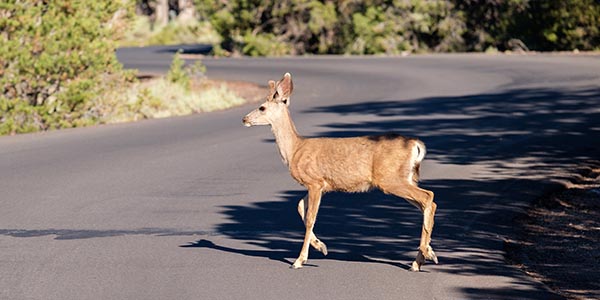Skunks emerge from hibernation and move across roadways.
Deer–vehicle accidents increase as year-old deer move to new areas.
Young wildlife are often left alone for hours at a time, leading people to incorrectly believe that they are orphaned.
Deer fawns are born in early summer and are sometimes left alone in people’s yards. Don’t disturb fawns, the mother is close even if you don’t see her.
Birds sometimes attack people, windows, or vehicles as they try to defend their nests.
Raccoons and opossums may raid improperly secured trash bins.
Coyotes and foxes take their young out to teach them to hunt.
Young animals leave their parents’ territory to find their own place to live. You may see them wandering through your neighborhood.
Bats may enter houses and other buildings to find a place to hibernate for the winter.
Deer–vehicle accidents peak from October to December.
Deer, turkey, and coyotes tend to exhibit grouping behavior and often become more daring as conditions for finding food become less favorable.
Deer herds will group together and can cause substantial damage to hedges and ornamental trees.
Rabbits and voles will strip bark off of shrubs and young trees as other food supplies become scarce.
Woodpeckers damage the siding of houses. Try to scare the birds away as soon as damage is noticed. Netting can be used to protect siding.
Animals fall into window wells. Place a board into the window well so that the animal can crawl out.
Beavers cut trees and shrubs and build dams that cause flooding of lawns, parks, or golf courses. If the flooding cannot be tolerated, contact a nuisance wildlife control operator to trap the beaver.
Deer-related damage to plants can occur year-round. Use fencing and repellents to control the amount of damage.
Deer–vehicle accidents can happen any time of year and any time of day or night. Be alert for deer moving across roads, especially in areas where trees are close to the road and during low-light conditions.
Coyotes may prey on pets. Do not leave small pets outside unattended, especially at night.


The Wildlife Illinois website was authorized by the Illinois Department of Natural Resources (IDNR) in partial fulfillment of project W-147-T. The website was developed by the National Great Rivers Research and Education Center, 2wav, and the IDNR in partnership with the United States Department of Agriculture Animal and Plant Health Inspection Service Wildlife Services and University of Illinois Extension to provide research-based information about how to coexist with Illinois wildlife.